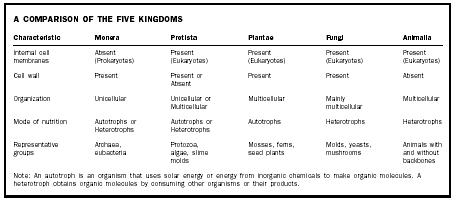Kingdom

Kingdom is the highest category in the hierarchical classification of organisms created by Carolus Linnaeus around 1750. Linnaeus recognized two kingdoms, plants and animals, a scheme that worked reasonably well for large multicellular organisms but failed as microscopes revealed diverse unicellular organisms. In 1959 Robert Whittaker devised a five-kingdom system that maintained kingdoms Plantae and Animalia but added kingdoms Monera, Protista, and Fungi (see Table).

| A COMPARISON OF THE FIVE KINGDOMS | |||||
| Characteristic | Monera | Protista | Plantae | Fungi | Animalia |
| Internal cell membranes | Absent Present (Prokaryotes) | Present (Eukaryotes) | Present (Eukaryotes) | Present (Eukaryotes) | Present (Eukaryotes) |
| Cell wall | Present | Present or Absent | Present | Present | Absent |
| Organization | Unicellular | Unicellular or Multicellular | Multicellular | Mainly Multicellular | multicellular |
| Mode of nutrition | Autotrophs or Heterotrophs | Autotrophs or Heterotrophs | Autotrophs | Heterotrophs | Heterotrophs |
| Representative groups | Archaea, eubacteria | Protozoa, algae, slime molds | Mosses, ferns, seed plants | Molds, yeasts, mushrooms | Animals with and without backbones |
| Note: An autotroph is an organism that uses solar energy or energy from inorganic chemicals to make organic molecules. A heterotroph obtains organic molecules by consuming other organisms or their products. | |||||
Whittaker placed bacteria in their own kingdom, Monera, because of fundamental organizational differences between prokaryotic bacterial cells, which lack membrane-enclosed nuclei and organelles , and the eukaryotic cells of other organisms that possess internal membranes. Plantae, Fungi, and Animalia consist of complex, multicellular eukaryotic organisms that differ from each other in details of cell structure and in how they secure and process energy. Protista is a collection of single-celled eukaryotic organisms and simple multicellular forms, some animal-like, some plantlike.
Molecular evidence, particularly from ribosomal ribonucleic acid (RNA), suggests that the five-kingdom scheme is also too simple. Some biologists believe that Protista should be partitioned into three or more kingdoms. Similarly, kingdom Monera contains two very biochemically distinct groups of prokaryotes: archaebacteria, and eubacteria. A proposed system acknowledges this ancient evolutionary split by creating a higher level of classification, domain, above kingdom. This system distinguishes three domains: Archaea, Eubacteria, and Eukarya (containing protists, plants, fungi, and animals).
SEE ALSO Animalia ; Archaea ; Eubacteria ; Fungi ; Linnaeus, Carolus ; Plant ; Protisa
Cynthia A. Paszkowski
Bibliography
Margulis, Lynn, and Karlene V. Schwartz. Five Kingdoms: An Illustrated Guide to the Phyla of Life on Earth. New York: W. H. Freeman and Company, 1998.